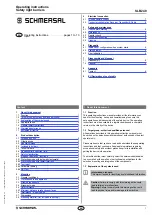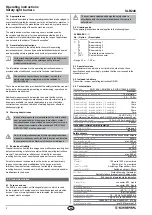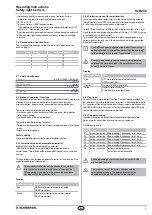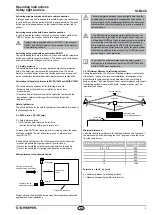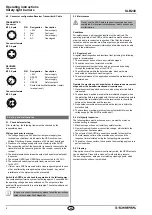
4
Operating instructions
Safety light barriers
SLB240
EN
Parameter setting with adapter cable KA-0977
• Switch the supply voltage off
• Connect adapter cable KA-0977 to the device
• Press and hold the integrated button and switch the supply voltage on
The button can be released as soon as the indicator of the receiver
changes from red to yellow and the indicator of the transmitter
changes from blue to yellow
• The AOPD is now in setup mode The signal strength is displayed
on the receiver through impulses or steady illumination of the
yellow LEDs
• To change to parameterisation, the button must be pressed briefly
(100 ms < T < 1500 ms)
• The status of parameter P1 is now indicated The signal lamp lights up
once in cyan (parameter is active) or magenta (parameter is not active)
• Press the button briefly to change to the next parameter The number
of light impulses indicates the parameter number, the colour indicates
the parameter status (cyan = active, magenta = not active)
• Press and hold the button (25 seconds < T < 6 seconds) and the
status of the current parameter changes from ACTIVE to NOT ACTIVE
or from NOT ACTIVE to ACTIVE and is saved While the button is
pressed, the indicator changes after 15 seconds to a static indication
of the current parameter setting Pressing and holding the button
longer T > 25 seconds indicates the colour of the new status The
button can now be released to save If the button is pressed and held
for longer than 6 seconds, the indicator goes out and the change is
not accepted
• To exit parameterisation mode, switch the supply voltage off and
restore the original wiring
Transmitters and receivers can be configured simultaneously
with adapter cable KA-0977
Parameter P6 restart interlock only acts on the receiver
The parameter is only indicated on the transmitter
Parameter setting without adapter cable KA-0977
As an alternative to the adapter cable, a button can be connected as
follows:
Wiring configuration
Transmitter
Wiring configuration
Receiver
+24VDC
2
3
4
1
0
VDC
not connected
Test
0 VDC
+24 VDC
2
4
3
1
5
+24VDC
0
VDC
OSSD 2
Authorised operation
+24 VDC
0 VDC
OSSD 1
2.8.5 Self-test
The AOPD carries out a self-test within 2 seconds after the power
supply is applied In the event of a fault, the AOPD is locked in the OFF
state and reports the status (see section on fault diagnosis)
After a successful self-test the AOPD switches to the ON state if the
protection zone is clear (automatic operating mode)
During operation, the system executes a cyclic self-test Safety-relevant
faults are detected within the reaction time and cause the outputs to be
put in the OFF state and an error code is indicated
3. Mounting
3.1 General conditions
The following guidelines are provided as preventive warning notices
to ensure a safe and appropriate handling These guidelines are an
essential part of the safety instructions and therefore must always be
observed and respected
• The AOPD must not be used on machines which cannot be
stopped electrically in case of emergency
• The safety distance between the AOPD and a hazardous
machine movement must always be observed
• Additional mechanical safety guards must be installed so that
the operator has to pass by the protection field to reach the
hazardous machine parts
• The AOPD must be installed so that the personnel is always
within the detection zone when operating the machine An
incorrect installation can lead to serious injuries
• Never connect the outputs to +24VDC If the outputs are
wired to +24VDC, they are in ON state, as a result of which
they are unable to stop a hazardous situation occurring on the
application/machine
• The safety inspections must be conducted regularly
• The AOPD must not be exposed to inflammable or explosive
gasses
• The connecting cables must be connected in accordance with
the installation instructions
• The fixing screws of the end caps and the mounting angle
must be firmly tightened
3.2 Protection field and approach
Additional protective devices must ensure that the operator has to pass
by the protection field to reach the hazardous machine parts
The AOPD must be installed so that personnel are always located
within the detection zone of the safety device when operating the
hazardous machine parts to be secure
3.3 Aligning the sensors
Procedure:
1 Transmitter and receiver must be fitted parallel to each other and at
the same height
2 First turn the transmitter and then the receiver so that the front
covers are opposite each other until the integrated signal lamp lights
up green (operating mode automatic) or yellow (operating mode
restart interlock)
3 Adjust the transmitter and receiver so that they are in the middle of
the angular range for a green or yellow indication Fix the position
with the two screws for the mounting bracket
3.4 Alignment mode
In this operating mode, the signal strength is indicated by yellow light
impulses The better the alignment, the higher the frequency of the light
pulses The alignment is optimal when the light pulses switch over to
continuous light
If there is no optical synchronisation between the transmitter and the
receiver, a light pulse is emitted every three seconds
Alignment mode is terminated by switching off the supply voltage

